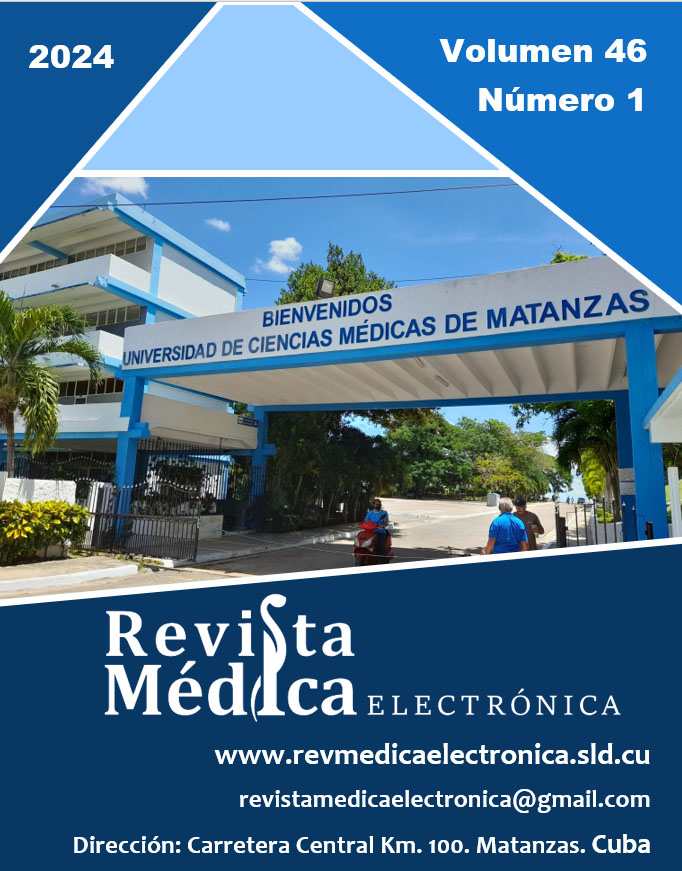Subtalamotomía mejorando camptocormia secundaria a enfermedad de Parkinson: un caso de estudio
Palabras clave:
camptocormia, enfermedad de Parkinson, alteraciones posturales, subtalamotomíaResumen
La camptocormia es una flexión extrema del tronco hacia delante, que desaparece en el decúbito supino, debido a múltiples causas. Se describe este trastorno postural infrecuente y su resolución con el tratamiento quirúrgico de la causa. Se presenta a un paciente masculino de 58 años con manifestaciones motoras progresivas, dadas por rigidez, temblor, bradicinesia, dificultad para la marcha, trastornos del lenguaje y alteraciones posturales. La camptocormia se convirtió en su característica distintiva. Se le realiza cirugía ablativa al núcleo subtalámico izquierdo por técnicas estereotácticas, mejorando, además de los síntomas parkisonianos, el trastorno grave de su postura. Se debe considerar a la enfermedad de Parkinson como una de las causas de la camptocormia, en sus estadios avanzados. Se ratifica al núcleo subtalámico como una diana eficaz y segura para tratar las manifestaciones motoras de la enfermedad de Parkinson idiopática, incluyendo este tipo de trastorno postural extremo. Este caso estimula a explorar más allá de los síntomas clásicos y a profundizar en las manifestaciones atípicas de la enfermedad de Parkinson idiopática.
Descargas
Citas
2. Miranda CM. Camptocormia: de lo psicogénico a lo orgánico, como etiología de una sorprendente alteración postural y de la marcha. Rev Med Chile. 2012;140:271-2. DOI: 10.4067/S0034-98872012000200019.
3. Yilmaz R, Wolke R, Puls N, et al. Characterizing Camptocormia in Parkinson's Disease Using Muscle Ultrasonography. J Parkinsons Dis. 2023;13(5):819-27. DOI: 10.3233/JPD-230037.
4. Sancho Saldaña A, Lázaro Romero A, Capablo Liesa JL, et al. Camptocormia as the main manifestation of a mutation in the POLG gene. Neurologia (Engl Ed). 2021;36(5):390-2. DOI: 10.1016/j.nrleng.2020.07.015.
5. Lehmann Urban D, Motlagh Scholle L, Alt K, et al. Camptocormia as a Novel Phenotype in a Heterozygous POLG2 Mutation. Diagnostics (Basel). 2020;10(2):68. DOI: 10.3390/diagnostics10020068.
6. Solís Cartas U, Ávalos Pérez MA, Rodríguez Moldón Y, et al. Camptocormia, a propósito de un caso. Rev Cubana Reumatol [Internet]. 2020 [citado 13/02/2024];22:(Supl 1). Disponible en: http://scielo.sld.cu/scielo.php?script=sci_arttext&pid=S1817-59962020000400011&lng=es
7. Rotondo J, Toro M, Bolívar M, et al. Dolor en la enfermedad de Parkinson. Una mirada a un aspecto poco conocido de esta patología. Rev Soc Esp Dolor [Internet]. 2019 [citado 13/02/2024];26(3):184-98. Disponible en: http://scielo.isciii.es/scielo.php?script=sci_arttext&pid=S1134-80462019000300008&lng=es
8. Wang F, He L, Zhao H, et al. Efficacy of Deep Brain Stimulation for Camptocormia in Parkinson's Disease: A Systematic Review and Meta-Analysis. J Integr Neurosci. 2023;22(1):11. DOI: 10.31083/j.jin2201011.
9. Molinari MC. Enfermedad de Parkinson como paradigma de la inestabilidad. La importancia de la terapia física como parte del tratamiento. Geriatría Clínica [Internet]. 2018 [citado 13/02/2024];12(1):27-33. Disponible en: https://adm.meducatium.com.ar/contenido/articulos/15300270033_1076/pdf/15300270033.pdf
10. Azher SN, Jankovic J. Camptocormia: pathogenesis, classification, and response to therapy. Neurology. 2005 Ago;65(3):355-9. DOI: 10.1212/01.wnl.0000171857.09079.9f.
11. Covaro A, Vilá Canet G, Ciccolo F, et al. Síndrome de la espalda inclinada. Presentación de cuatro casos y revisión de la bibliografía. Rev Asoc Argent Ortop Traumatol [Internet]. 2019 [citado 13/02/2024];84(4):393-406. Disponible en: http://www.scielo.org.ar/scielo.php?script=sci_arttext&pid=S1852-74342019000400011&lng=es
12. Lai Y, Song Y, Su D, et al. Pallidal stimulation as treatment for camptocormia in Parkinson's disease. NPJ Parkinsons Dis. 2021;7(1):8. DOI: 10.1038/s41531-020-00151-w.
13. Solomon Cardona MT, Gallo Rodríguez JL, Ricardo de la Fe Y, et al. Subtalamotomía bilateral en dos tiempos para los pacientes con enfermedad de Parkinson Idiopática. Salud Cienc Tecnol [Internet]. 2023 [citado 13/02/2024];3:578. Disponible en: https://dialnet.unirioja.es/servlet/articulo?codigo=9129623
Publicado
Cómo citar
Número
Sección
Licencia
La misma permite:
• Copiar y redistribuir el material publicado en cualquier medio o formato.
• Adaptar el contenido.
Esto se realizará bajo los siguientes términos:
• Atribuir los créditos de los autores e indicar si se realizaron cambios, en cuyo caso debe ser de forma razonable.
• Uso no comercial.
• Reconocer la revista donde se publica.
Se mantienen los derechos de autoría de cada artículo, sin restricciones.







